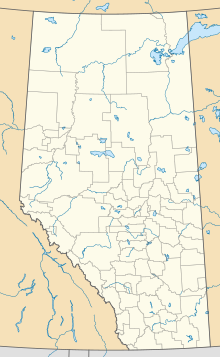Ashmont, Alberta
Ashmont | |
|---|---|
 | |
Location of Ashmont in Alberta | |
| Coordinates: 54°07′45″N 111°34′05″W / 54.12917°N 111.56806°W | |
| Country | Canada |
| Province | Alberta |
| Census division | No. 19 |
| Municipal district | County of St. Paul No. 19 |
| Area (2021)[1] | |
| • Land | 1.11 km2 (0.43 sq mi) |
| Population (2021)[1] | |
| • Total | 125 |
| • Density | 112.2/km2 (291/sq mi) |
| Time zone | UTC−7 (MST) |
| • Summer (DST) | UTC−6 (MDT) |
Ashmont, Alberta is a hamlet in northern Alberta, Canada within the County of St. Paul No. 19.[2] It is located near the intersection of Highway 28 and Highway 36, approximately 33 kilometres (21 mi) northwest of the Town of St. Paul. It has an elevation is 2,073 feet (632 m).
Ashmont is surrounded by numerous lakes, such as Upper Mann Lake, Batty Lake, Lottie Lake, Floatingstone Lake and Garner Lake. Many provincial recreation areas are established on the shores of these lakes.
A first settler named the community after his native home in Ashmont, Boston.[3] Ashmont began as a farming community in the early part of the 20th century. At its peak in the 1960s it boasted a grain elevator, four general stores, a pool hall, Legion Hall, two gas stations and a school. As is typical of many small rural communities it has fallen on hard times. Only one store remains, kept alive by the local lake communities and a relatively large school (K to 12).
Demographics
[edit]| Year | Pop. | ±% |
|---|---|---|
| 1941 | 106 | — |
| 1951 | 146 | +37.7% |
| 1956 | 187 | +28.1% |
| 1961 | 152 | −18.7% |
| 1966 | 156 | +2.6% |
| 1971 | 150 | −3.8% |
| 1976 | 119 | −20.7% |
| 1981 | 196 | +64.7% |
| 1986 | 222 | +13.3% |
| 1991 | 202 | −9.0% |
| 1996 | 176 | −12.9% |
| 2001 | 160 | −9.1% |
| 2006 | 149 | −6.9% |
| 2011 | 188 | +26.2% |
| 2016 | 133 | −29.3% |
| 2021 | 125 | −6.0% |
| Source: Statistics Canada [4][5][6][7][8][9][10][11][12][13][14][15][16][17][1] | ||
In the 2021 Census of Population conducted by Statistics Canada, Ashmont had a population of 125 living in 51 of its 59 total private dwellings, a change of -6% from its 2016 population of 133. With a land area of 1.11 km2 (0.43 sq mi), it had a population density of 112.6/km2 (291.7/sq mi) in 2021.[1]
As a designated place in the 2016 Census of Population conducted by Statistics Canada, Ashmont had a population of 133 living in 47 of its 65 total private dwellings, a change of -29.3% from its 2011 population of 188. With a land area of 1.11 km2 (0.43 sq mi), it had a population density of 119.8/km2 (310.3/sq mi) in 2016.[17]
See also
[edit]References
[edit]- ^ a b c d "Population and dwelling counts: Canada and designated places". Statistics Canada. February 9, 2022. Retrieved February 10, 2022.
- ^ "Specialized and Rural Municipalities and Their Communities" (PDF). Alberta Municipal Affairs. June 3, 2024. Retrieved June 14, 2024.
- ^ Place-names of Alberta. Ottawa: Geographic Board of Canada. 1928. p. 13.
- ^ Ninth Census of Canada, 1951 (PDF). Vol. SP-7 (Population: Unincorporated villages and hamlets). Dominion Bureau of Statistics. March 31, 1954. Retrieved September 19, 2024.
- ^ Census of Canada, 1956 (PDF). Vol. Population of unincorporated villages and settlements. Dominion Bureau of Statistics. October 25, 1957. Retrieved September 19, 2024.
- ^ 1961 Census of Canada: Population (PDF). Series SP: Unincorporated Villages. Vol. Bulletin SP—4. Ottawa: Dominion Bureau of Statistics. April 18, 1963. Retrieved September 19, 2024.
- ^ Census of Canada 1966: Population (PDF). Special Bulletin: Unincorporated Places. Vol. Bulletin S–3. Ottawa: Dominion Bureau of Statistics. August 1968. Retrieved September 19, 2024.
- ^ 1971 Census of Canada: Population (PDF). Special Bulletin: Unincorporated Settlements. Vol. Bulletin SP—1. Ottawa: Statistics Canada. March 1973. Retrieved September 19, 2024.
- ^ "Geographical Identification and Population for Unincorporated Places of 25 persons and over, 1971 and 1976". 1976 Census of Canada (PDF). Supplementary Bulletins: Geographic and Demographic (Population of Unincorporated Places—Canada). Vol. Bulletin 8SG.1. Ottawa: Statistics Canada. May 1978. Retrieved September 19, 2024.
- ^ 1981 Census of Canada (PDF). Place name reference list. Vol. Western provinces and the Territories. Ottawa: Statistics Canada. May 1983. Retrieved September 19, 2024.
- ^ 1986 Census of Canada (PDF). Population. Vol. Unincorporated Places. Ottawa: Statistics Canada. July 1988. Retrieved September 19, 2024.
- ^ 91 Census (PDF). Population and Dwelling Counts. Vol. Unincorporated Places. Ottawa: Statistics Canada. June 1993. Retrieved September 19, 2024.
- ^ 96 Census (PDF). A National Overivew: Population and Dwelling Counts. Ottawa: Statistics Canada. April 1997. Retrieved September 19, 2024.
- ^ "Population and Dwelling Counts, for Canada, Provinces and Territories, and Census Divisions, 2001 and 1996 Censuses - 100% Data (Alberta)". Statistics Canada. August 15, 2012. Retrieved September 19, 2024.
- ^ "Population and dwelling counts, for Canada, provinces and territories, and designated places, 2006 and 2001 censuses - 100% data (Alberta)". Statistics Canada. July 20, 2021. Retrieved September 19, 2024.
- ^ "Population and dwelling counts, for Canada, provinces and territories, and designated places, 2011 and 2006 censuses (Alberta)". Statistics Canada. February 8, 2012. Retrieved September 19, 2024.
- ^ a b "Population and dwelling counts, for Canada, provinces and territories, and designated places, 2016 and 2011 censuses – 100% data (Alberta)". Statistics Canada. February 8, 2017. Retrieved February 13, 2017.

